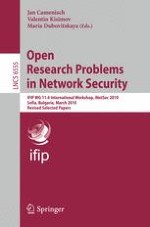2011 | Buch
Open Research Problems in Network Security
IFIP WG 11.4 International Workshop, iNetSec 2010, Sofia, Bulgaria, March 5-6, 2010, Revised Selected Papers
herausgegeben von: Jan Camenisch, Valentin Kisimov, Maria Dubovitskaya
Verlag: Springer Berlin Heidelberg
Buchreihe : Lecture Notes in Computer Science
